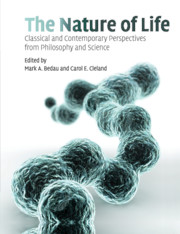Book contents
- Frontmatter
- Contents
- Preface
- Acknowledgments
- Sources
- About the authors
- Introduction
- SECTION I CLASSICAL DISCUSSIONS OF LIFE
- SECTION II THE ORIGIN AND EXTENT OF NATURAL LIFE
- SECTION III ARTIFICIAL LIFE AND SYNTHETIC BIOLOGY
- SECTION IV DEFINING AND EXPLAINING LIFE
- 23 Definitions of life
- 24 The seven pillars of life
- 25 A universal definition of life: autonomy and open-ended evolution
- 26 Does ‘life’ have a definition?
- 27 Sentient symphony
- 28 What is life?
- 29 Universal Darwinism
- 30 What is life? Was Schrödinger right?
- 31 Four puzzles about life
- Supplementary bibliography on life
- Index
- References
29 - Universal Darwinism
Published online by Cambridge University Press: 10 November 2010
- Frontmatter
- Contents
- Preface
- Acknowledgments
- Sources
- About the authors
- Introduction
- SECTION I CLASSICAL DISCUSSIONS OF LIFE
- SECTION II THE ORIGIN AND EXTENT OF NATURAL LIFE
- SECTION III ARTIFICIAL LIFE AND SYNTHETIC BIOLOGY
- SECTION IV DEFINING AND EXPLAINING LIFE
- 23 Definitions of life
- 24 The seven pillars of life
- 25 A universal definition of life: autonomy and open-ended evolution
- 26 Does ‘life’ have a definition?
- 27 Sentient symphony
- 28 What is life?
- 29 Universal Darwinism
- 30 What is life? Was Schrödinger right?
- 31 Four puzzles about life
- Supplementary bibliography on life
- Index
- References
Summary
It is widely believed on statistical grounds that life has arisen many times all around the universe (Asimov 1979; Billingham 1981). However varied in detail alien forms of life may be, there will probably be certain principles that are fundamental to all life, everywhere. I suggest that prominent among these will be the principles of Darwinism. Darwin's theory of evolution by natural selection is more than a local theory to account for the existence and form of life on Earth. It is probably the only theory that can adequately account for the phenomena that we associate with life.
My concern is not with the details of other planets. I shall not speculate about alien biochemistries based on silicon chains, or alien neurophysiologies based on silicon chips. The universal perspective is my way of dramatizing the importance of Darwinism for our own biology here on Earth, and my examples will be mostly taken from Earthly biology. I do, however, also think that “exobiologists” speculating about extraterrestrial life should make more use of evolutionary reasoning. Their writings have been rich in speculation about how extraterrestrial life might work, but poor in discussion about how it might evolve. This essay should, therefore, be seen firstly as an argument for the general importance of Darwin's theory of natural selection; secondly as a preliminary contribution to a new discipline of “evolutionary exobiology.”
- Type
- Chapter
- Information
- The Nature of LifeClassical and Contemporary Perspectives from Philosophy and Science, pp. 360 - 373Publisher: Cambridge University PressPrint publication year: 2010
References
- 2
- Cited by



